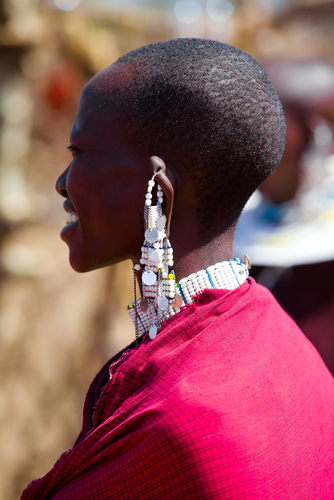No Design Schools? No Problem for This Emerging Fashion Hub
Sheria Ngowi never went to design school. But that hasn’t stopped the Tanzanian law graduate from designing haute couture that he now showcases alongside some of the biggest names in the fashion industry. Elsewhere, Ngowi’s success without formal training may appear rare. In Tanzania, he’s one of a growing set of designers making it big, despite taking that route.
The East African nation’s Swahili designers are overcoming the absence of a developed domestic fashion industry to increasingly take their collections of clothes woven in traditional colors and flamboyant prints to top international runways, major global boutique stores and wardrobes across the world. Only South Africa has a higher literacy rate among Africa’s 10 most populous nations, but Tanzania’s formal education system has largely bypassed fashion — the country lacks even a single major design school. But a rising breed of millennial designers is substituting the absence of that formal design education with raw skill and ambition, and is coupling an increasing global appetite for diverse designs with a desire to give back to the country, to carve out a success story.
Pan-African designer Mustafa Hassanali, one of the continent’s biggest fashion brands today, is a medical doctor by training, but his collections that use the traditional East African cotton fabrics kitenge and khanga have drawn rave reviews in more than 20 countries. In 2008, Nasreen Kareem became Miss Tanzania. But she had bigger dreams. Today, she runs Enjipai, a beaded jewelry brand that has buyers worldwide — she has presented her work to former Mozambican and South African first lady Graça Machel and former President Mary Robinson of Ireland. Ally Rehmtullah, designer of the year at Swahili Fashion Week 2017, has taken his work to London Fashion Week and across Africa. And Ngowi has showcased his work at the New York, Paris, London and South Africa fashion weeks.
“As a young African designer, finding myself alongside the likes of David Tlale, Paul Smith, Burberry and Tom Ford was completely surreal,” says Ngowi. “This gave me impetus to continue breaking boundaries.”
The success of Tanzanian designers isn’t restricted to those based in the East African nation — those now settled in the U.K and the U.S. are making waves too. Anna Lukindo, who runs a high-end designer brand based out of London, has had her work featured in the city’s high-profile fashion week and Black History Week. North Carolina-based Tanzanian fashion entrepreneur Lilian Danieli runs the popular Nashona boutique store, which sources its clothes from Tanzania. Her clients include celebrities like actress Angela Bassett and singer Indie Arie, and span the world, she says, “from Paris to Tokyo.”
Back in Tanzania, challenges pothole the road ahead for the country’s emerging designers. The absence of design schools is one. A lack of scale in production and inadequate capital for designers are others. When Rehmtullah took his work to London Fashion Week, an excited buyer there ordered 1,000 pieces. “As a Swahili designer, I wanted to give something that is made in Tanzania,” he recalls. “Unfortunately I did not have the production capacity back home, and I had to pass.” Nashona’s Danieli nearly quit in the boutique’s second year after a batch of ordered clothes turned up with wrong sizing. “That held me back a little, but I got up,” she says.
But the gains Tanzanian designers are making are unmistakable. Social media is helping. Since it started selling products on Facebook, Instagram and e-commerce platform Etsy, Enjipai has begun to make inroads into the European and American markets, says Kareem. The internet is helping Sheria’s employees communicate from where they’re based, across time zones and diverse geographic locations. He now plans to launch his own online store for customers to purchase his designs directly, and hopes to set up physical stores in Johannesburg, Cape Town, Lagos, Nairobi, Accra, Kinshasa, Abidjan and Cairo. And Nashona, says Danieli, doubled its profits between 2016 and 2017.
This emerging generation of Tanzanian designers is also planting the seeds of a more robust and sustainable fashion industry, with a regular supply of creative young men and women. They’re serving up the future generation a set of role models who have shown that homegrown Tanzanian designers can be successful. Sheria started out as a designer in Mysore, India, but returned. As did Kareem, who was pursuing modeling in South Africa after her beauty pageant win, before returning to design jewelry in Tanzania. And Rehmtullah is working with Italian design house Peroni to hold training sessions and competitions for young Tanzanian designers never exposed to fashion schools.
But the broader world of fashion is benefiting too. In the past, it took West-based designers like John Galliano, Thakoon Panichgul and Matthew Williamson to hero Swahili wear globally through East African designed collections and runways. Not anymore.

